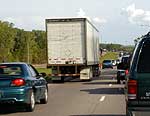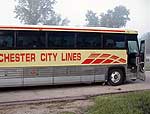By Erin Galbally
Minnesota Public Radio
June 5, 2002
Minnesotans are spending more time commuting to work than they were 10 years ago, according to the latest data from the U.S. census. That means more cars are on the roadways and workers are traveling farther to their jobs. Surprisingly, the greatest increases in commuting time occurred outside the metro. While carpooling and use of public transportation in the Twin Cities has not grown, the census results indicate some rural counties are increasingly reliant on alternative means of transportation.
| |
|
|
|
||
It's early morning in the tiny town of Spring Valley, Minn. Out of the mist appear nurses, dental technicians, and medical secretaries. All are ready to board a public bus destined for the Mayo Clinic in Rochester, roughly 30 miles away.
Connie Brandt wears medical scrubs and carries a book bag. She's taken the bus to work for the past three years. Brandt says the bus saves her money and the convenience is hard to beat.
"It takes about 15 minutes at night longer and 15 minutes longer in the morning, and that 15 minutes is worth my time not to have to drive," says Brandt.
Jean Hust also does the weekday commute. Hust lives outside of Spring Valley and drives to the bus each morning.
"I love it. I hope it never stops," says Hust. "It's one of the strongest drawing points to come here to live, because you have the best of both worlds. You have Mayo and you have great transportation. What more can you ask for?"
According to the most recent census results, Fillmore County commuters like Brandt and Hust are on the rise. In fact, the area known primarily for its rural landscape and tons of farmland, nearly tops the statewide list for growth in public transportation use. Other southeastern Minnesota counties such as Wabasha and Mower also saw a big increase.
| |
|
|
|
||
As it turns out, much of that can be attributed to the Mayo Clinic, which is also southeastern Minnesota's largest employer. Since 1998, Mayo has sent roughly 20 buses five days a week to pick up workers. The buses criss-cross the southeast, from Winona to Cannon Falls to Austin. All are areas that contribute to Mayo's Rochester workforce of more than 25,000.
Michael Ziemann oversees Mayo's transportation efforts. Ziemann says the bus system helps decrease traffic, which ultimately saves the clinic money.
"There are some gains from a financial impact, whether it be the cost of a parking space or shuttling people to a remote lot. Bus passes are still a financial advantage for Mayo to be able to provide its employees, rather than a parking pass," says Ziemann.
Mayo plans to open up all of its bus lines to the rest of the public by next year.
Brian Jorgenson of Minnesota's Department of Transportation says outstate communities need more transportation choices like the ones offered to Mayo employees. Jorgenson says the growth in commute times comes as financing for roadways and other projects declines.
"The demand for our public transportation systemis...going to increase too. I think a lot of people are already experiencing that, thanks to worse conditions on our roadways. The roadways are becoming rough and hard to travel on," says Jorgenson.
The Mayo bus system doesn't receive state money. It's unlikely employers in other state communities can shoulder the cost of such a system alone. That means workers in Todd, Grant, Wadena and Marshall counties will continue to face more time behind the wheel on local roadways across the state.
More from MPR

